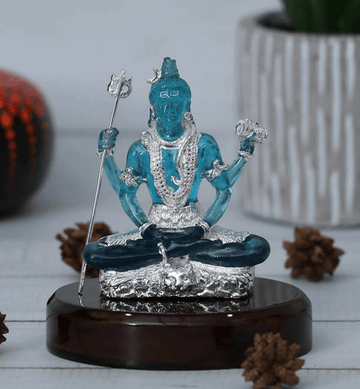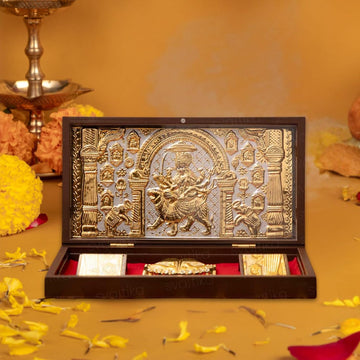In Hinduism, Lord Shiva is one of the principal deities of the Trimurti, which also includes Brahma (the creator) and Vishnu (the preserver). Shiva, known as the destroyer or transformer, represents the cyclical nature of existence—birth, death, and rebirth. His role is vital in maintaining the balance of the universe by destroying the old and making way for new creation.
Lord Shiva's vast mythology, cosmic significance, and unique characteristics make him a deity revered by millions. He is known by many names, including Mahadeva, Maheshwar, Rudra, and Shankar, each representing different aspects of his divine nature.
Symbolism of Lord Shiva
Lord Shiva is known for his complex and multi-dimensional nature, which reflects the paradoxical aspects of existence. Here are some of the key symbols associated with him:
- The Third Eye (Trinetra)
Shiva is often depicted with a third eye in the center of his forehead. The third eye symbolizes wisdom, perception, and the ability to see beyond ordinary reality. It represents spiritual insight, and when opened, it has the power to destroy evil and ignorance. It is believed that Shiva’s third eye destroyed Kama, the god of love, when Kama tried to disturb Shiva during his meditation.
- The Crescent Moon
The crescent moon adorning Shiva's head represents the cyclical nature of time and the mind. It is also symbolic of control over time and cosmic rhythm. The moon on his forehead signifies the coolness of his consciousness amidst the heat of destruction and the endless cycle of creation, preservation, and destruction.
- The Trishul (Trident)
Shiva’s weapon, the Trishul (trident), represents the three aspects of existence: creation, preservation, and destruction. It also symbolizes the three gunas (qualities)—Sattva (purity), Rajas (activity), and Tamas (inertia). It is a weapon that has the power to destroy ignorance and evil, and it is associated with the spiritual warrior’s ability to fight inner demons.
- The Snake Around His Neck
Shiva is often depicted with a snake coiled around his neck. The snake represents the primal energy, and it is a symbol of transformation and eternity. It also represents the control over desires and the ability to overcome ego. The snake's hood is associated with Kundalini energy, which is believed to lie dormant within humans until awakened.
- The Damru (Drum)
Shiva holds a damru, a small drum that represents the cosmic sound or rhythm of creation, often described as the Nada Brahman or the sound of the universe. The sound of the damru symbolizes the beginning of creation and is thought to represent the eternal sound of the universe.
- The Mount Kailash
Mount Kailash, believed to be Shiva's sacred abode, is a symbol of his transcendence and eternal peace. It is a place of both material and spiritual fulfillment, a realm of absolute stillness where Shiva meditates in solitude. Kailash is often depicted as the center of the universe and represents the highest spiritual realization.
- Ashes (Vibhuti)
Shiva is often smeared with ashes (vibhuti), which represent the impermanence of life. It signifies the destruction of the material body and the ultimate transcendence of the soul. The ashes are a reminder that physical beauty and wealth are fleeting, and spiritual awakening is the true pursuit.
Lord Shiva’s Roles and Manifestations
Lord Shiva is often referred to as the "destroyer" in the trinity of Hindu gods, but this title is misleading if not understood in the context of his transformative power. He is not a destroyer in the negative sense, but more in the sense of transformation and regeneration. His destruction is necessary for creation to continue in its cyclical rhythm.
- The Cosmic Dancer – Nataraja
One of the most iconic depictions of Lord Shiva is as Nataraja, the cosmic dancer. In this form, Shiva is seen performing the Ananda Tandava (dance of bliss) inside a ring of fire. The dance represents the five activities (Pancha Krityas) that are essential for the cycle of the universe:
- Srishti(Creation)
- Sthiti(Preservation)
- Samhara(Destruction)
- Tirobhava(Concealment)
- Anugraha(Grace)
In his dance, Lord Shiva’s movements symbolize the ebb and flow of the universe. The universe is born, maintained, and eventually destroyed through this divine rhythm.
- The Lord of Yogis – The Supreme Ascetic
Shiva is also the Lord of Yogis, often depicted in a meditative pose, symbolizing his control over the mind and mastery of meditation. He is regarded as the Adi Yogi (the first yogi), and many of the teachings of yoga and spiritual discipline are attributed to him. His deep meditative state indicates a supreme state of consciousness, where he is beyond duality and the fluctuations of the mind.
- Shiva as Ardhanarishvara
In this unique form, Shiva is depicted as being half male and half female, joined with his consort Parvati. This form is called Ardhanarishvara, symbolizing the inseparable unity of the masculine and feminine principles. It represents the balance of opposites and the idea that the divine is neither male nor female but a union of energies.
- Shiva as Bhairava
Bhairava is a fierce form of Shiva, representing his destructive and wrathful aspect. Bhairava is often depicted as a terrifying figure, holding weapons and terrifying enemies. Bhairava is invoked to remove fear, conquer negative energies, and protect the devotee from harm.
The Family of Shiva
Lord Shiva’s family plays an important role in Hindu mythology and his worship.
Parvati (His Consort)
Shiva’s consort, Parvati, is the goddess of fertility, love, and devotion. She is also known as Shakti, the divine feminine energy, which is the creative power that makes existence possible. Parvati represents the nurturing and loving aspect of Shiva, while he represents destruction and regeneration.
Ganesha (The Elephant-headed Son)
Ganesha, the beloved son of Lord Shiva and Parvati, is widely worshipped as the remover of obstacles and the god of wisdom and beginnings. His image with the elephant’s head and pot-belly, along with his role as the Vighnaharta (remover of obstacles), is symbolic of wisdom and learning, as well as overcoming challenges.
Kartikeya (The Warrior Son)
Kartikeya, also known as Murugan in southern India, is another son of Shiva and Parvati. He is depicted as a warrior god, riding a peacock and wielding a spear. Kartikeya represents strength, valor, and the destruction of evil.
Worship of Shiva
Shiva is worshipped in various forms across the world. One of the most iconic symbols of Shiva is the Shivalinga, a representation of the divine masculine energy and a focus of worship in many temples.
- Lingam Worship: The Shiva Lingam is a stone or abstract symbol representing Shiva, and it is worshipped in temples and homes across India and the world. Devotees offer water, milk, flowers, and sacred bilva leaves to the Shiva Lingam, chanting mantras like "Om Namah Shivaya" to invoke Shiva’s blessings.
-
Mantras for Shiva:
- Om Namah Shivaya– The most powerful and well-known mantra, meaning "I bow to Shiva."
-
Mahamrityunjaya Mantra– A prayer for protection and healing:
"Om Tryambakam Yajamahe, Sugandhim Pushtivardhanam, Urvarukamiva Bandhanan, Mrityor Mukshiya Mamritat."
- Puja and Rituals: Shiva is typically worshipped with rituals that include offerings of water, milk, honey, ghee, and fruits. Many devotees also observe fasting and meditation to connect with the divine.
Festivals Dedicated to Shiva
Maha Shivaratri is the most significant festival dedicated to Lord Shiva. It is celebrated annually, during the 14th night of the dark fortnight in the month of Phalguna (usually February or March). Devotees fast, chant mantras, perform night-long vigils, and offer prayers to seek Shiva’s blessings for peace, prosperity, and liberation.
Conclusion: The Many Faces of Lord Shiva
Lord Shiva’s complexity and multifaceted nature make him one of the most profound and widely revered deities in Hinduism. He is both the destroyer and the creator, the ascetic and the householder, the warrior and the loving father. Whether in his role as Nataraja, the cosmic dancer, or as Adi Yogi, the supreme teacher of yoga, Shiva embodies the paradoxes of existence and guides his devotees toward self-realization.
House of Wemy offers intricately crafted Lord Shiva Idols designed to enhance your home’s spiritual aura and also for Car Dashboard. Explore our collection online and find the perfect Idol for your home!










